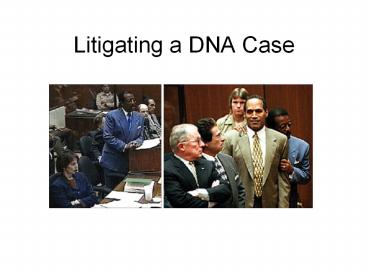Litigating a DNA Case PowerPoint PPT Presentation
Title: Litigating a DNA Case
1
Litigating a DNA Case
2
Frye v. United States. 1923.The Frye Standard
- Lie-detector (polygraph test).
- Sufficiently established to have gained general
acceptance by scientific community. - The Frye court bestowed on judges a gatekeeping
function.
3
Federal Rules of Evidence, 1975
- In an effort to establish uniformity, the Supreme
Court put the following into law - Rule 104(a)- allows the court to determine the
qualifications of a person to be a witness and
the admissibility of evidence. - Rule 702- allows for judges to permit expert
testimony. - Rule 402- allows judges to admit all relevant
evidence. - Rule 403- allows judges to exclude relevant
evidence based on its value, if its deemed
potentially confusing or misleading, or if its
considered a waste of time. - Gave more power to the judges.
- Promoted judges from gatekeepers to masters of
the courtroom.
4
Daubert v. Merrell Dow Pharmaceuticals, Inc.
1993. The Daubert Standard.
- Has the scientific technique been tested?
Validity? - Peer review or publication?
- Is the rate of error known?
- What is the degree of acceptance?
5
TWGDAM and SWGDAM
- TWGDAM- Technical Working Group on DNA Analysis
Methods. - Established to assure that DNA testing was
performed reliably. - SWGDAM- Scientific Working Group on DNA Analysis
Methods. - Recommend revisions to quality assurance
standards. - Serve as a forum to discuss, share, evaluate
forensic biology methods. - Recommend and conduct research to develop and
validate methods.
6
Admissibility of RFLP Data
- Andrews v. State. 1987.
7
STR and mtDNA Decisions
- PCR-STR DNA Evidence- 9 cases in California.
- Usually not disputed, but there are exceptions.
- People v. Bokin. 1999.
- State v. Pfenning. 2000.
- People v. Shreck. 2000.
- Mitochondrial DNA- 1 case in California.
- Not as clearly established as PCR-STR based
testing. - Admissible in at least 18 states.
- Inadmissible- State v. Crow. 1998.
8
Exonerating the Innocent
- The Innocence Project
- Barry Scheck and Peter Neufeld 1992
- Rape and homicide
- 280 inmates exonerated as of 12/1/2011
- Most cases received go unresolved
- 48 states allow for postconviction DNA testing,
but some of the laws are limited
9
- DNA Exonerations By Year In US
10
- Factors Leading To Wrongful Convictions
11
Roger Keith Coleman
- Roger waiting for an interview on death row in
the Greensville Correctional Center, Jarratt, VA,
May 20,1992. - New DNA tests confirmed the guilt of Coleman, who
went to his death in Virginia's electric chair in
1992.
12
Defending DNA Evidence
- Use an expert/s
- Admission of DNA test results
- Admission of statistics
- Admission of an explanation of the DNA results
13
Attacking DNA Evidence
- Use an expert/s
- Admission of DNA test results
- Admission of statistics
- Admission of an explanation of the DNA results
14
Admission of DNA test results
- New type of DNA test
- Expert not qualified to testify to DNA results
- Laboratory not accredited
- Testing not performed by certified technicians
- Lack of discovery material or notice with respect
to the admission - Improperly obtained DNA evidence
- DNA profile should have been purged from database
15
Admission of Statistics
- Expert not qualified to testify to statistics
- Statistics do not conform to standards accepted
by the scientific community - Improper database used
16
Admission of an explanation of the DNA results
- Expert not qualified to testify to statistics for
specific context - Attacking laboratory techniques and conditions
- Use of accepted techniques
- Quality control and assurance
- Use of proficiency testing and audits
- Laboratory error
17
General Routes of Attack
- DNA test that is used
- Chain of custody
- Expert Witness
- Contamination
- Choice not to employ several different DNA tests,
sequencing - Use of PCR
- Preventing testimony regarding the issue being
decided

